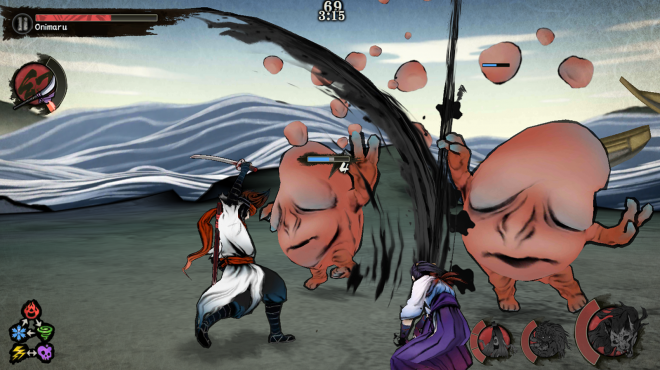

Yamaguchi piles every single ingredient – brass, shamisen, booming percussion, aggressive shouts – on top of each other, pushing the cue towards ever more intense heights to arrive at a wonderfully powerful climax. “The Rush of Battle”’s fierce call-and-response pattern between brass fanfares and combined shamisen and vocals leads into the soundtrack’s most dazzling moment. Here as on “The Rush of Battle”, Yamaguchi uses the shamisen’s wiry timbre to add greater attack to the churning rhythms. The solo woodwinds play counterpoint to the fiery passion of the – occasionally monotonous – rhythmic thrust but never take away from its power. Warrior chants and frenzied Japanese percussion create a suitably turbulent backdrop for Yamaguchi’s tense woodwind writing that soars above the rhythmic onslaught, giving the music direction and compelling drama. “Flaring Tempers” is the World of Demons soundtrack’s first action cue and also its least convincing one – although thankfully, that’s a relative measure which only indicates the score’s overall excellent quality. And while the composers seamlessly combine Japanese and Western (orchestral) influences, it’s really the solo instruments’ contributions that carry the score’s melodies and atmosphere. While most scores aiming for an unmistakably Japanese sound are happy to stick to shakuhachi and shamisen, Yamaguchi and Harada add three more solo woodwind – shinobue, nohkan and hichiriki – to the mix. The instrumentations on World of Demons underline these artists’ knowledge of Japanese folk music. However, that stylistic combination is still not often heard on game scores, and the composers prove themselves experts in this particular idiom. Yes, the score is heavily rooted in traditional Japanese music, and one half of the (short) album consists of action pieces. Another familiar face involved here was Shota Nakama, musical director of the Video Game Orchestra, handling the game’s orchestral arrangements.Ĭonsidering the game’s visual and gameplay style, the World of Demons soundtrack moves along a few predictable lines. PlatinumGames certainly didn’t skimp on the game’s music budget, which allowed for several live performers playing traditional Japanese instruments, as well as a 19-piece string ensemble – the Synchron Stage Orchestra in Vienna, which had just performed on Shigeru Umebayashi’s Kalpa of Universe. However, he had previously worked with Yamaguchi on Bayonetta 2, Star Fox Zero and Star Fox Guard. Naofumi Harada’s scoring background wasn’t as extensive. For Yamaguchi, this was an opportunity to return to the traditional Japanese music that had graced his scoring debut, 2006’s Okami, followed by his work on Bayonetta, Anarchy Reigns and Star Fox Zero.

World of Demons’ lavish (at least by mobile game standards) presentation extended to its soundtrack, written by PlatinumGames’ co-founder and chief composer Hiroshi Yamaguchi, and Naofumi Harada. Ultimately, reviews for the game were respectable rather than extraordinary, with critics praising its combat and art direction while finding fault with World of Demons‘ repetitive level structure. Given PlatinumGames’ reputation as the action game auteurs behind titles like the Bayonetta franchise and Nier: Automata, World of Demons‘ announcement as a hack and slash inspired by Japanese mythology caused some excitement. That’s precisely what happened to World of Demons, PlatinumGames’ first published foray into mobile gaming (it’s hard to ignore the fact that the developer’s previous mobile title – much-touted all-star JRPG Lost Order – was never released).
World of demons platinumgames full#
It’s very rare for a game to receive a limited release in a handful of second-tier markets, get pulled from store shelves within a few months – only to receive a second, worldwide release a full three years later. World of Demons Soundtrack, Naofumi Harada / Hiroshi Yamaguchi, 2021


 0 kommentar(er)
0 kommentar(er)
